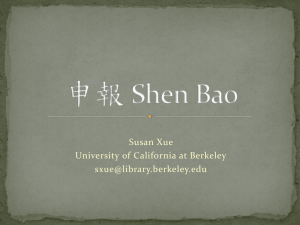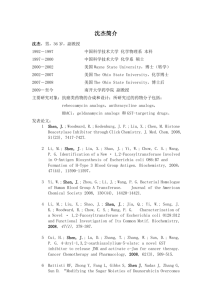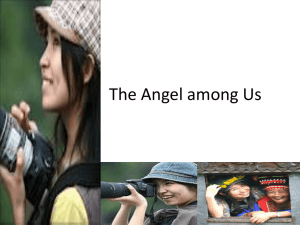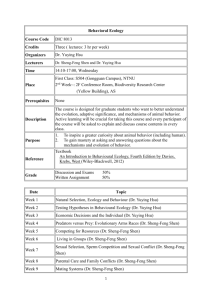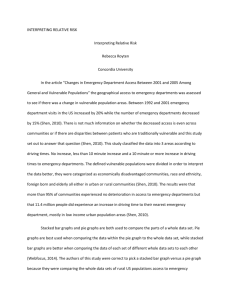Something Rich and Strange: Lyricism, Violence, and
advertisement
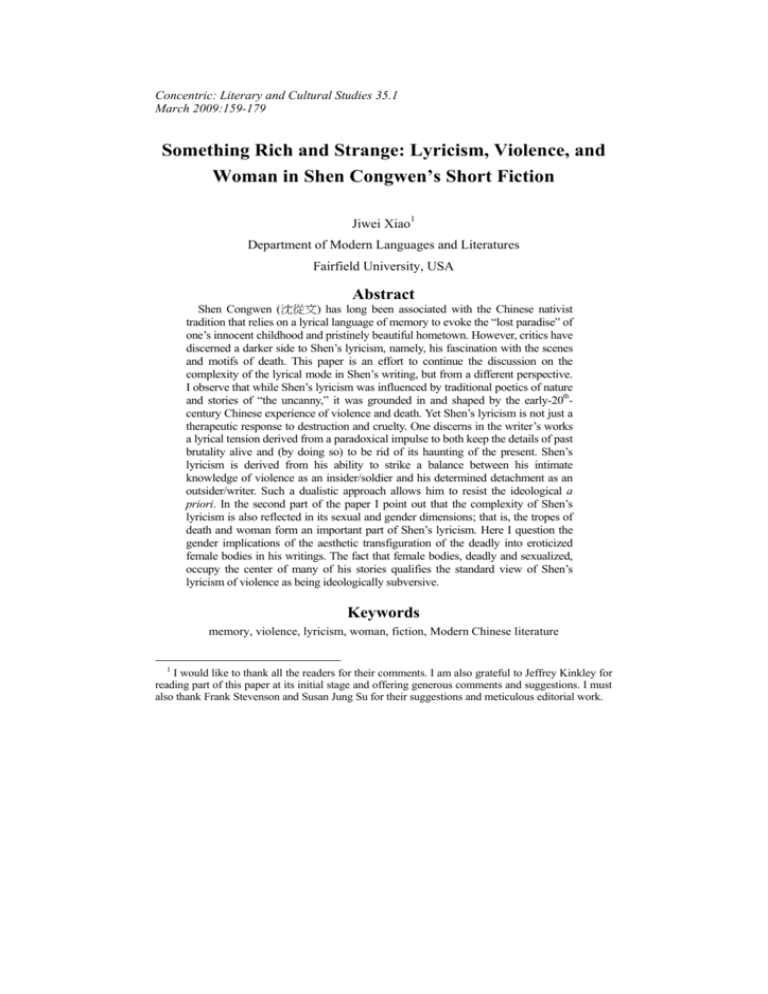
Concentric: Literary and Cultural Studies 35.1 March 2009:159-179 Something Rich and Strange: Lyricism, Violence, and Woman in Shen Congwen’s Short Fiction Jiwei Xiao1 Department of Modern Languages and Literatures Fairfield University, USA Abstract Shen Congwen (沈從文) has long been associated with the Chinese nativist tradition that relies on a lyrical language of memory to evoke the “lost paradise” of one’s innocent childhood and pristinely beautiful hometown. However, critics have discerned a darker side to Shen’s lyricism, namely, his fascination with the scenes and motifs of death. This paper is an effort to continue the discussion on the complexity of the lyrical mode in Shen’s writing, but from a different perspective. I observe that while Shen’s lyricism was influenced by traditional poetics of nature and stories of “the uncanny,” it was grounded in and shaped by the early-20thcentury Chinese experience of violence and death. Yet Shen’s lyricism is not just a therapeutic response to destruction and cruelty. One discerns in the writer’s works a lyrical tension derived from a paradoxical impulse to both keep the details of past brutality alive and (by doing so) to be rid of its haunting of the present. Shen’s lyricism is derived from his ability to strike a balance between his intimate knowledge of violence as an insider/soldier and his determined detachment as an outsider/writer. Such a dualistic approach allows him to resist the ideological a priori. In the second part of the paper I point out that the complexity of Shen’s lyricism is also reflected in its sexual and gender dimensions; that is, the tropes of death and woman form an important part of Shen’s lyricism. Here I question the gender implications of the aesthetic transfiguration of the deadly into eroticized female bodies in his writings. The fact that female bodies, deadly and sexualized, occupy the center of many of his stories qualifies the standard view of Shen’s lyricism of violence as being ideologically subversive. Keywords memory, violence, lyricism, woman, fiction, Modern Chinese literature 1 I would like to thank all the readers for their comments. I am also grateful to Jeffrey Kinkley for reading part of this paper at its initial stage and offering generous comments and suggestions. I must also thank Frank Stevenson and Susan Jung Su for their suggestions and meticulous editorial work. 160 Concentric 35.1 (March 2009) In 2002, Shen Congwen quanji (沈從文全集 The Complete Works of Shen Congwen) was published in mainland China. This came after two decades of re-printing the writer’s stories, novels, essays, travelogues and literary criticism, almost all of which were written and originally published between the 1920s and 1940s. What happened to Shen Congwen (1902-1988) is a story that students of modern Chinese literature are now familiar with: after decades of literary oblivion, the once officially-banned writer has been placed back again into the modern Chinese literary canon and indeed is revered as one of the most important practitioners of Chinese nativist literature (鄉土文 學). The recognition of Shen’s influence on writers of 1980s’ “searching-for-roots” literature (尋根文學) only solidifies his rehabilitated status.2 Yet it still seems that there is something “rich and strange” in Shen’s writings that prevents him from becoming truly popular among contemporary Chinese readers. Except for the novel-length fiction Biancheng (邊城 Border Town, 1934) and two travelogues, Xiangxing sanji (湘行散記 Random Sketches on a Trip to Hunan, 1934) and Xiangxi (湘西 West Hunan, 1938), most of his works remain unknown and unread, including many that deal with such “unwholesome” subjects as death and erotic love. For many Chinese scholars and critics, Shen’s lyricism is mainly a pastoralist’s nostalgia for the “lost paradise” of his hometown and of a pre-industrialized China.3 This “sanitized” view of Shen is an ironic reminder of the devastating attack on him by Guo Moruo ( 郭 沫 若 ), a romanticist-turnedrevolutionary cultural bureaucrat. Guo, in a 1948 article, labeled Shen as a “peachcolored writer” of stories of decadence and eroticism.4 In the US, the image of Shen as a purely idealistic pastoral writer was corrected to a great extent by Jeffrey Kinkley’s Odyssey of Shen Congwen, a literary biography about the many-faceted life and literary accomplishments of the writer.5 In addition, David Der-wei Wang’s 2 For a detailed discussion of this topic, see, among other sources, Jeffrey Kinkley’s article “Shen Congwen’s Legacy in Chinese Literature of the 1980s.” 3 See for example, the articles published in Congwen Xuekan (從文學刊 Collected Studies on Shen Congwen), Vol. 1. See Xiang Chengguo (向成國). 4 According to Liu Hongtao (劉洪濤), Guo Moruo’s article was only one of the many that followed the leftist line and use the discourse of class in its attack on Shen. 5 In different places in The Odyssey of Shen Congwen, Kinkley discusses eroticism in Shen’s fiction. He mentioned the influence of Freud and other Western writers on Shen as well as the author’s personal background coming from a region and an ethnic culture that has a relatively liberal sexual mores and customs. Xiao / Something Rich and Strange 161 innovative reading of the macabre and uncanny in Shen’s writings sheds new light on the writer’s achievements as a modernist writer.6 To a great extent, this paper is an effort to continue the discussion of the complexity of the lyrical mode in Shen’s writing, in particular its “dark” and “strange” side. I observe that Shen’s lyricism was not just a “therapeutic” approach to death and destruction but rather was grounded in and shaped by the early-20thcentury Chinese experience of violence and death. One discerns in Shen’s works a lyrical tension between the impulse to keep the details of past brutalities alive and the impulse to be rid of their haunting of the present. This tension led to the author’s paradoxical striving to be both historically truthful and lyrically imaginative. It gave rise to a lyricism of violence in his writing. There are two sides to this issue. On the one hand, by showing the disjunction between his uncomprehending non-heroic characters and their real social and historical positions, Shen delineates the crushing impact on individuals of the violent force of historical events. The writer is particularly good at using details to turn abject moments of cruelty and death into moments of great lyricism. On the other hand, Shen also points us towards the uncanny side of the violent past by associating death with desire and fantasy. Indeed, what is so fascinating about Shen’s “deadly” lyricism is its sexual and phantasmal elements. For, even more frequently than those anonymous decapitated corpses that haunted the author’s memory of his military past, women’s dead bodies appear at the center of the fictional death scenes, so frequently indeed that this cannot be dismissed as the author’s temporary lapse into frivolous fantasy. I also observe here that while the desirable woman is aestheticized and eroticized to represent the life-affirming force, she is often turned into an uncanny being, fantastic yet frozen under the objectifying male gaze, neither living nor dead, neither a human nor a thing. Can it be possible that the violence experienced and remembered by the male writer has been displaced onto the woman’s body and transmuted into fictional eroticism? I. At the end of his short story “Sange nanzi he yige nuren” (三個男子和一個女 人 Three Men and One Woman, 1930), Shen Congwen says, “Certain things in the 6 See David Der-wei Wang’s Fictional Realism in 20th-Century China: Mao Dun, Lao She, Shen Congwen. Also see Wang’s book The Monster that is History, in which he provides a detailed analysis of the “decapitation syndrome” in Modern Chinese literature. 162 Concentric 35.1 (March 2009) past have been constantly gnawing me. When I speak out, you think that I am only telling a story. No one knows how one lives with a mind burdened by hundreds of stories in his life” (576). 7 What stories were there in Shen’s memory that so disturbed him? In Fictional Realism in 20th-Century China: Mao Dun (茅盾), Lao She (老舍), Shen Congwen, David Der-wei Wang draws upon Shen’s autobiographical as well as fictional works to paint a harrowing picture of what the author might have seen and experienced in his early life: In Autobiography of Congwen, Shen Congwen relates how the Miao aborigines were beheaded by the thousands after the failure of their rebellions in the late Qing period; how, on the eve of the Republican revolution, local agitators were arrested and put to death by chopping off their heads; and how this cruel form of execution still went on wherever warlords came to seize local power. As a child, Shen Congwen saw thousands of heads hung out for display on the city wall, or simply dumped on the river bank before family members sorted them out. More appalling is his account of soldiers often arresting innocent peasants to fulfill their daily quota; after too many killings, they let their captives gamble their lives in a lottery-like religious ritual. The winners were set free, while the losers had to resign their lives to Fate. Thus, it was not unusual to see an unlucky peasant bid farewell to his cellmates and ask them to settle things unfinished at home for him (“Twilight”); a sad child walking towards home on a mountain path, carrying baskets containing the heads of his father and his brother (“Little Scene in Guizhou”); or even more gruesomely, dogs fighting for the decomposed bodies left on the river banks. (Fictional Realism in 20th-Century China 210-11) Decapitated bodies also became a common sight to Shen Congwen after he joined the warlord’s army. Unlike most of his fellow writers, Shen served in the military before he started his writing career. At the age of 13, he was already “a replacement soldier (yubeibing 預 備 兵 or buchongbing 補 充 兵 ) before later serving in the local army as a reservist. In 1922, when he was 20 years old, Shen left the army for Beijing to seek educational opportunities. The name “Congwen” 7 The English translations of Shen Congwen’s works in this paper, except for the story “The New and the Old,” are mine. Xiao / Something Rich and Strange 163 (“dedicated to culture”), which he gave himself before he went to the city, clearly indicates his resolve to cultivate his scholarly interests.8 But there are also other reasons that lie behind Shen’s decision to make a career change: the deaths of his friends, his disgust at warlord politics and cruelties, and his exposure to May Fourth freethinking through magazines and journals. 9 Jeffrey Kinkley, in The Odyssey of Shen Congwen, observes: He left the military in 1922, but only after a reevaluation of his own life. The alternative to a military career he sought then was not an updated way of forging a new national collectivism through modern party-armies. Rather it was an updated conception of the scholarly career—a career in pursuit of values that lay above the state, before which soldiers were but servants, as in Old China, Young China, and the modern West. What Shen Congwen began to react against in his warlord career was not discipline—for the military life he knew was relaxed and relatively egalitarian, as “innocent” as he—but violence, and military participation in the affairs of state. He was preparing himself to reject both Nationalist and Communist solutions for China as well, and ultimately become a pacifist. (42-43) Here I want first to expand upon Kinkley’s observation of Shen’s rejection of the military life by asking: Could it be that the sight of “beheading” became a turning point in the life of Shen Congwen too, just as it had been in the life of Lu Xun (魯 迅 1881-1936)? In his famous “Preface to Call to Arms” (吶喊自序) the older writer recalls: I have no idea what improved methods are now used to teach microbiology, but in those days we were shown lantern slides of microbes; and if the lecture ended early, the instructor might show slides of natural scenery or news to fill up the time. Since this was during the Russo-Japanese War, there were many war slides, and I had to join in the clapping and cheering in the lecture hall along with the other students. It was a long time since I had seen any compatriots, 8 According to Kinkely, “Congwen” is actually a variation on “Chongwen” (reverence for culture), a name given by an old judge advocate that Shen had befriended in the army. 9 Please see Shen Congwen’s Congwen zizhuan (從文自傳 Autobiography of Congwen). Also see Chapter Two of Jeffrey Kinkley’s The Odyssey of Shen Congwen. 164 Concentric 35.1 (March 2009) but one day I saw a newsreel slide of a number of Chinese, one of them bound and the rest standing around him. They were all sturdy fellows but appeared completely apathetic. According to the commentary, the one with his hands bound was a spy working for the Russians who was to be beheaded by the Japanese military as a warning to others, while the Chinese beside him had come to enjoy the spectacle. (vi-vii) The image on the lantern slide so traumatized young Lu Xun that he lost his belief in the cause of medicine and, by extension, any vocation believed to be beneficial merely to “the body”: Before the term was over I had left for Tokyo, because this slide convinced me that medical science was not so important after all. The people of a weak and backward country, however strong and healthy they might be, could only serve to be made examples of or as the witnesses of such futile spectacles; and it was not necessarily deplorable if many of them died of illness. The most important thing, therefore, was to change their spirit; and since at that time I felt that literature was the best means to this end, I decided to promote a literary movement. (vii) This story has been cited and commented upon many times, and its meaning has been reduced to a trite message: witnessing the spiritual apathy of the Chinese people led to the birth of a writer and symbolically to the birth of a new national literature, a literature whose larger goal was to enlighten and reform this same people. Some prominent scholars in Chinese studies in the US have offered new readings of the “lantern slide” incident. David Der-wei Wang seizes on Lu Xun’s ambivalence and points to the epistemic “complicitousness” of his spectatorship (214-16). Wang’s revisionist reading places much emphasis on the mixed psychological and ideological implications of Lu Xun’s representation of mutilation and beheading. Rey Chow, from her postcolonialist-film-critic’s perspective, focuses more on the “menacing” power of the medium of the lantern slide itself—its “direct, cruel, and crude power” to showcase the inferiority of a third-world country as a spectacle in the transnational imperialist context. For Chow it is the awareness of the “enviable effects” of the medium itself that led to Lu Xun’s conscious exploration Xiao / Something Rich and Strange 165 of a new representational mode that ideally would have similar effects of transparency and immediacy (4-11). However, while one may find certain filmic elements in Lu Xun’s literary realism, it is hard to show that this is the result of the writer’s “conscious reaction” to film as a medium. Rather, it is precisely the “unconsciousness” of the power and violence of the lantern slide film—due to its deceptively transparent nature—that causes the shock. Lu Xun’s anguish and angst are premised on his very belief in the “truthfulness” of the image. Such a belief in the correspondence between exteriority and interiority, one which disregards the possible gap between the two, seems to underline Lu Xun’s approach to his fictional characters. One may find that a large part of the effectiveness of Lu Xun’s realism lies in his vividly drawn characters with identifiable personal features. It is easy to “see” these characters, often through the eyes of an intellectual I-narrator. Yet, one also notices that the latter’s gaze tends to linger on the exterior of the characters—often lower-class figures. The gaze is not returned, so to speak.10 Moreover, the inner anguish of Lu Xun’s I-narrator and the spiritual malaise perceived by him can be traced back to that original shock, to the belief that those spectators on the lantern slide were indeed as apathetic and sick in spirit as they look. However, could it be possible that the image Lu Xun saw was a random result of the camera? After all, it was not even a “movie” but merely a photo. Here I do not intend to investigate the “truthfulness” of Lu Xun’s experience and story, nor do I deny its significance in modern Chinese literary history. I am also not naïve enough to believe that this was indeed the single revelatory moment, dramatic as it was. I tend to think that, whether what he actually “saw” was a real or a somehow distorted image, the young Lu Xun’s witnessing of the decapitation scene suddenly crystallized all his prior knowledge of himself and his countrymen. Still, the arbitrariness of Lu Xun’s viewing angle as a spectator justifies the following questions: What if the beheading were watched not on the slide but right on the spot? What if death were encountered not as an image but as an actual “experience”? What if the spectators, those who looked expressionless and impassive on the slide, did have real feelings of anger, fear, indignation, and sympathy? What would happen if one of the spectators left the crowd and went back to write what he saw? What would he say? A spectator Shen Congwen surely was. In Congwen zizhuan ( 從 文 自 傳 Autobiography of Congwen, 1934), the writer describes how as a military secretary he recorded the trials and punishments of the local villagers: 10 Xianglin’s Wife in Lu Xun’s “New Year Sacrifice” ( 祝福), Kong Yiji in “Kong Yiji” (孔乙 己) and the adult Runtu in “My Old Home” (故鄉) are perhaps the most well-known examples. 166 Concentric 35.1 (March 2009) When those ignorant peasants were being beaten, I was sitting there as usual preparing court transcripts, copying down whatever confessions they muttered out under the pain of torture. And then soldiers would swab some ink onto their palms and let them press their fingerprints in the blank space at the bottom of the transcript paper. The documents would finally be given back to me to put in order and submit to the military judge for case filing. (64-65) The narrator’s voice is decidedly detached. We are not sure what he thinks and feels. What results is a transcription of “what happened,” rendered so meticulously objective that it sounds callous. But this is what Shen the soldier had seen: massacres of local people en route became a routine for the warlord army and beheading a source of entertainment for the bored soldiers and officers. Reading his autobiography, the inexperienced reader sometimes cannot distinguish Shen the young rookie soldier from his comrades, who looked at the decapitated prisoners with either perverse curiosity or total indifference.11 At one point, the narrator even mimics a soldier’s swaggering tone as he comments on one of his battalion’s missions to purge local bandits (qingxiang 清鄉)—“Now it was our battalion’s turn to do this kind of thing. We only killed two thousand people altogether!” (56). The unabashedly excited voice instantly creates an ironic distance between the writer and the narrator. This irony results in a skewed criticism of the absurd violence and its perpetrators, one obviously more effective than a straightforward denunciation or a guilty confession. Interestingly, despite his admission of his own dubious role in the massive abuse of the military penal system, Shen expresses his indignation toward not the perpetrators but those who had no chance to see the brutality with their own eyes. His experience as a first-hand witness of excessive violence and death seems to have given him an extraordinary sense of self-assurance and moral superiority. He was empowered by his insight into the darkness of humanity: I stayed there (Huaihua) for a year and four months, and during this time I witnessed about 700 killings. Under what circumstances people would be beaten during the prosecution, and in what kind of state they would be beheaded, I knew thoroughly. It was hard to put 11 See the two chapters in Congwen zizhuan, “Qing xiang suo jian” (清鄉所見) and “Huaihua zhen” (懷化鎮). Xiao / Something Rich and Strange 167 into words the so-called human stupidities. This experience weighed on my mind, making me no longer able to feel the same love and hate as those in the city who read classics. There and in other places, I saw the stupid things never seen by ordinary people, heard the cries never heard by ordinary people, and smelled the odors never smelled by ordinary people. I was no longer interested in the moral ideas generated from the narrow and commonplace life of the city people. When I came to the city, I felt unlike a normal human being. I was gloomy and desolate. (Congwen zizhuan 58) Shen’s criticism of the “unseeing” urbanites again reminds us of Lu Xun, who similarly sets himself against those who look on but do not “see.” Both writers, young at the time, were shocked into maturity not only by death itself but also by the implicit meaning of being an onlooker. Lu Xun puts so much symbolic meaning into the act of “standing by” that it incriminates all his fellow countrymen as accomplices in the crimes against the victimized (both people and nation). Yet has not Shen Congwen’s own life story contradicted this master narrative of impassive spectatorship? For although Shen was an unperturbed and unfeeling military secretary and soldier in his self-portrait, he turned out not to be a heartless spectator after all. On the contrary, his insider’s knowledge and his memory would one day help him to transform that experience into something of great lyric power. The different “viewing angles” adopted by the two writers also meant different approaches to death and violence in their writing. While Lu Xun’s encounter with beheading prompts his great angst in the face of the absence and/or loss of individual agency and social-symbolic integrity, in the case of Shen Congwen one cannot locate such a pronounced turning point in his works, a point where the unspeakable pain catalyzes an emotional and intellectual revolution in the author-as-witness. For Shen’s “lyrical composure” leaves that primary shock untraceable. Yet he is able to present us with a powerful depiction of barbarism from the land of darkness and death, one brought forth in the uncanny moment between remembering and forgetting, as we see in “The Old and the New” (新與舊, 1935). II. “The Old and the New” is a story which, perhaps due to its obscure subject and allegorical ambiguity, has attracted little attention from critics. The story could 168 Concentric 35.1 (March 2009) well have been given a more catchy title, for instance “The Last Executioner.” But obviously Shen is uninterested in writing a legend. The main character, Warrior Yang Jinbiao (楊金標), is a military headsman. He seems to be based on someone Shen knew when he was in the army, perhaps a man often seen at the carnivorous post-beheading feasts in Congwen Zizhuan: The day of executions sometimes coincided with the market day. Then there would be people selling pork and beef in the market. Followed by two cooks carrying a bamboo basket, the headsman would, according to the custom, take that bloody broadsword and cut some meat from each butcher’s table. And then the pork and beef would be evenly distributed for stew on fire stoves. Wine would be gulped down without limitation. When everyone got a little bit tipsy, someone would stand up unsteadily. Lifting up his chopsticks he would make a playful swipe at the back of the neck of someone squatting there eating and drinking. And then there would be a great havoc of wrestling, laughing, and shouting. (60-61) In many ways, Warrior Yang Jinbiao is also an unremarkable and uncouth figure. But Yang, in his prime, is a soldier skilled in martial arts and a “distinguished headsman” working for the local yamen (衙門), the imperial district government. The first part of the story, predicting the future of the young executioner, ends on a hopeful note: Yang Jinbiao was twenty-four and a bachelor. He cut a fine, healthy figure of a soldier, being free and without a care. He was known for his generosity and skill in all things. He had dreams of future glory: “A tower a mile high must start from the ground.” His companion in the ranks, too, felt he was not a fellow to be underestimated. (Shen, “The Old and the New” 10) One paragraph later, we are told that the overthrow of the last emperor has ended the career of the headsman. His martial-arts skill is rendered useless by guns, the modern instruments of execution adopted by the new government. As his glorious past is “slowly but completely forgotten” the dashing headsman becomes an old man, keeping his menial job as the gatekeeper and living a very mundane life (12). The story takes a dramatic turn, however, when one day he receives an order Xiao / Something Rich and Strange 169 to behead two prisoners in public; the real motive behind this strange order is not revealed until the very end of the story. “So the local military who thought up this new gambit had put to death two Communists, not by firing squad but by an extraordinary measure: they had asked the old executioner who guarded the city gate to cut off their heads, that they might be exposed in public as a warning to others” (28). Although a firing squad can kill people more efficiently, it is believed to be less intimidating than the old-fashioned way, the way of corporeal mutilation. Despite his confusion, Warrior Yang successfully accomplishes the task. Then from force of habit, as soon as he sees blood gushing from the prisoner’s neck he runs towards the local temple. Yet no one except the headsman himself knows and remembers the old ritual: that an executioner should be proclaimed guilty by the imperial magistrate after completing his deed; then he must go immediately to the temple, crawl under the altar and pray for the god’s pardon. Everyone, therefore, believes that Warrior Yang is a madman when they see him running like crazy into the temple with a sword in hand that is dripping blood. After a stand-off with the authorities who besiege the temple, the headsman is captured, disarmed, humiliated and whipped. Not long afterward, he is dead. The story can certainly be read as a political allegory, a comment “on the current New Life Movement (新生活運動) which was in full swing when Shen wrote the story.”12 The New Life Movement, inaugurated by Chiang Kai-shek in 1934, stressed the revival of traditional moral virtues such as politeness (li 禮), propriety (yi 義), integrity (lian 廉), and self-respect (chi 恥). But this was actually part of the KMT’s attempt to “ideologically remold areas that had previously been Soviets” such as Jiangxi (江西) province.13 The detail given at the end of the story, that the two young people beheaded by Warrior Yang were suspected of underground communist activities, is therefore not casually added. Just as beheading, a legacy of imperial China, is here revived by the government as a terrorizing tactic, the New Life Movement was a counterrevolutionary attempt to strengthen the KMT’s political and ideological control. 12 It is also significant that, according to Jeffrey Kinkley, Shen chose to publish the story in Duli pinglun (獨立評論), not a mainly literary journal but one concerned with current affairs and opinions. Hu Shi (胡適), who was critical of the KMT’s cultural policies, was one of the main forces behind the journal. Surrounding the publication of the story, there was another factor—the story came after Shen’s friend Ding Ling (丁 玲 ) was arrested. All above information and comments provided by Professor Kinkley are cited from his emails to me. 13 For a detailed discussion of the “New Life Movement,” see Arif Dirlik’s article “The Ideological Foundations of the New Life Movement: A Study in Counterrevolution.” 170 Concentric 35.1 (March 2009) With its theme announced in its title, “The Old and the New” can also be read as an allegory of Chinese modernity caught in-between its barbaric imperial past and the no less violent Republican present. In the story, the only real change that the revolution has brought to the town is the modernization of the method used by the government to dispatch its prisoners: The era changed; the last emperor’s power was overthrown by the revolutionary party, and the miracle of the famous Qing dynasty headsman who beheaded six people in a trice without leaving any skin dangling would never happen again. But, when the era changed and “the court” became “the government,” the local methods of controlling people became crueler. Small though the town was, it would usually dispatch eight or ten people at a time. The bravest and most dashing man around couldn’t get through so many if they were as easy to slice as cucumbers. So the authorities just lined up the people and shot them. Yang Jinbiao became the old soldier guarding the North Gate, the one who bolted and locked it at night. His days of glory were past; as the seasons went by, he and his profession were slowly but completely forgotten. (12) Compared with the “modern” way of killing people the old method may appear primitive and yet, in a perverse way, also more “humane.” No matter how meaningless (to the point of being farcical) it looks, the old ritual practiced by the executioner and the imperial magistrate, which Shen describes vividly at the beginning of the story, at least incorporates the recognition of the fact that depriving another man of his life is a crime. The magistrate and the headsman’s collaborative public “performance” can therefore be seen as an attempt to alleviate the shock or guilt experienced by the collective psyche. The “madness” felt by the ex-headsman, on his way to the killing ground, represents the insanity lying beneath the normalcy of a modern penal culture, one now mechanized, sanitized, and unburdened of fear and religious trappings. What is most striking in the story, however, is Shen’s deeply lyrical vision of the human tragedy, of an uncomprehending individual caught in the twists and turns of history. Unlike Uncle Kang (康大叔) in Lu Xun’s short story “Medicine” (Yao 藥), whose rough, vulgar appearance and butcher-like demeanor befit his profession and externalize his inner cruelty, Warrior Yang just seems an ordinary person. Beheading prisoners is a job he is given to do and can do well thanks to his physical Xiao / Something Rich and Strange 171 prowess and martial arts skills. His ability to compartmentalize his life as well as his psyche also allows him to later settle into a peaceful retired life, and age into a content and friendly old man: Being a drinker, he often went over to Butcher Yang’s table to chat and wash his wine down with a bowl of soup flavored with pork bone marrow. Or he’d go to the table of Bucher Sha, the Muslim, and carry back a sheep’s head or sheep’s stomach to enjoy at home. He knew something of herbal medicine, so, whenever someone came down with a blister or a boil, he was happy to go off into the countryside to pick the healing plants. And, being a good fisherman, he often went by himself up to the mill embankment to fish in the reservoir. When his catch was stewed, he would carry it in its earthenware casserole up to the other soldiers in the gate tower, and they would all feast raucously together, playing the guess-fingers game as they drank. In the dog days of summer, when it was hot as a bamboo steaming basket, he still lay down in a ventilated spot of the gate tower and snored away. While the soldiers practiced Chinese boxing, making him itch to join them, he, too, would take up his antique shields and practice “seizing the spear,” “bringing down the flyingwedge yoked troika by cutting down the end horse at the knees,” and other quaint exercises. (14, 16) But it is the old soldier’s capacity for memory that makes him an appropriate fictional “hero.” In order to make a character of no particular talent “speak” to us about his past, Shen Congwen uses a deceptively simple technique—let his possessions “speak” for the character. With an extraordinary flair for detail, Shen describes to us the various objects that decorate the interior of Warrior Yang’s home. Some belong to the present, such as that fishing rod with which the old man whiles away his time during the day. Some are keepsakes from his previous life as a headsman, such as that quaint set of weapons and accessories. Each weapon is given an accurate description—“two leather shields, a matched pair of ‘tiger-head swords’ with curved tips sharp as hooks, an old Guangdong Arsenal-style musket, and a pair of daggers ” (12). What stands out from among these objects that now serve as memorabilia for the protagonist, however, is a sword. The narrator zooms in on it with almost fetishistic attentiveness: 172 Concentric 35.1 (March 2009) And the precious sword that had beheaded so many people hung at the head of his bed. Thirty years before, it was said that the sword delivered a portent one day before the yamen was to order an execution. Now that the Republic had come and the sword lay unused, the portents came no more. But when the sword was pulled from its scabbard, even today it gave off a terrifying, cold gleam, as if unwilling yet to despair of itself. On the edge of its blade could still be seen many a semicircular bloodstain that would not come off with grinding. Having nothing to do during the day, the old soldier took it with him to the top of the city hall, where he sat on a rusted cannon in the battery, stroking and admiring the sword as he basked in the warm sunlight. And, when he was in the mood, he put it through a few exercises. (12) The picture of an ex-headsman stroking, admiring and sometimes brandishing his irrevocably bloodstained sword in the warm sunset light as he himself approaches the end of his life is an extraordinary one. The old soldier lives outside history, oblivious to its changes. Time is frozen, arrested in the moment of reconciliation with the violence of the past. This is also a high point of lyricism in the text. The inner world of the simple character, while overshadowed by a grotesque past and its faint smell of blood, is illumined by the uncanny light of the sword. Indeed, the lyrical realism of violence might well have been undermined by sentimentalism if it were not for that little detail the narrator points us to—“many a semicircular bloodstain that would not come off with grinding” (12). The bloodstains could not be removed from the old soldier’s memory either. In the second part of the story, the writer goes to great lengths to delineate the ex-headsman’s confusion at the sudden recall of him to the execution ground, a place he hasn’t been to in years—“It all happened in such a rush, in such chaos, that the old soldier thought he was dreaming. Everything was hazy in this dream; he couldn’t verify any of it, so he did run outside the West Gate” (18). To the old man, something has gone terribly wrong beneath the quietude: the trappings and props for performing a decapitation—the tribunal, the shed for the officers, and the spectators—are not there. The peace and normalcy of the outsider world are set in sharp contrast to the chaos that grows inside the character, deepening his inner confusion. Ironically, blood is the only thing “real” enough to jolt Warrior Yang back to his senses: “Seeing the blood spurt out made him think Xiao / Something Rich and Strange 173 that this dream would soon be over” (22). This is an enigmatic sentence. With a great gift for imaginative empathy and compassion, Shen lets his humble character speak a profound paradox: by resorting to the memory of a bloody past, one hopes to rid oneself of its haunting in the present. III. There is another aspect to Shen’s lyrical representation of his “encounter with death.” One notices that it is the dead women, rather than the anonymous bodies seen by Shen himself, that often occupy the center of the death scenes in his fiction. These women are strewn throughout his early stories, from the tribal myths to the Buddhist tales, from military yarns to modern short stories. “Meijin, Baozi, yu na yang” (媚金,豹子,與那羊 Meijing, Baozi, and the Kid, 1929), “Shenwu zhi ai” (神巫之愛 The Shaman’s Love, 1929), “Sange nanren yu yige nuren,” “Ye” (夜 Night, 1930), and “Yisheng” ( 醫 生 Doctor, 1931) are just a few examples. Hovering over the dead woman’s body is the gaze of a hopelessly late perfectionist lover (“Meijin, Baozi and the kid”), a terrified midnight intruder (“Shenwu zhi ai”), a hijacked doctor (“Yisheng”), and a young story-junkie soldier (“Ye”). Is there a connection between the gaze of Shen Congwen the soldier and scopophilia in his fictions? Can it be that Shen has shifted his unreturned gaze from real headless bodies to fantasized female ones? How do we interpret the possible gender implication of these imaginary encounters with death? In this final section I will explore these issues through a reading of the intertwined tropes of death and desire in two short stories: “Sange nanzi he yige nuren” and “Yisheng.” “Sange nanzi he yige nuren” deals with a subject rarely touched upon in modern Chinese literature—necrophilia. With the help of Congwen zizhuan we can trace the source of the story to something Shen “could never forget,” something that had happened during his stay in Huaihua as a soldier (Shen 159). Among the many prisoners kept by his troops there was a tofu-maker who had dug a young local girl out of her tomb at the end of the day on which she was buried. He carried the corpse to a cave where he slept with her for three days. Caught when he returned her to the tomb, the man was quickly convicted and sentenced to death. However, he showed neither fear nor regret. Preoccupied with his reflections on “the beauty” of this young woman, he was totally unconcerned about his situation. When a soldier reminded him of his imminent death, he only smiled at him. This was indeed a small, almost trivial “incident” considering the scale of the massive killings carried out by Shen’s troops at the time. However, not only did the writer mention it again in his second travelogue, 174 Concentric 35.1 (March 2009) Xiangxi, he also developed it into a full story with “Sange nanren he yige nuren” and returned to it once more in another short story called “Yisheng.” The one tofu-maker in Shen Congwen’s memory is multiplied into three admirers in “Sange nanzi he yige nuren”—the “I”-narrator/soldier, his bugler friend, and the tofu-maker. The two soldiers befriend the tofu-maker because his shop provides them a vantage point from which they can catch glimpses of a beautiful young girl, the daughter of a rich local businessman. Throughout the story, however, the girl remains nameless and faceless, invisible to the reader just as she is out of reach for the three men. Their lower socio-economic status allows them only to indulge in daydreams and fantasies. They even envy the two dogs that always accompany the girl. In fact, the animalistic image of the dogs is the only “realistic” detail about the girl, who appears in and soon disappears from their life like “a star, a rainbow” (566). For some unknown reason, the girl commits suicide by swallowing gold. The two soldiers are at first distraught at the news, then feel elated, and in the end fall into a state of numb depression. The bond between the three men is broken as a result of her death. The tofu-maker, the quietest one, disappears, and the I-narrator climbs into bed, trying to forget everything through sleep. In a halfwaking, half-sleeping state, he sees his bugler friend come back from outside, with mud all over him and scratches on his face. The latter then confesses to him his intention to resurrect the dead girl and his discovery of the empty coffin. It turns out that the tofu man has already moved the girl’s body to a cave. She is later found “sleeping nakedly on the stone bed, the blue cornflowers scattered all over her and the floor” (576). Contrary to what had happened in the original story, the narrator says, “the news, enriched by details of people’s ignorance, was stripped of obscenity and turned into a myth” (576). Despite the central place occupied by the girl, what engages the reader’s attention is really the fascinating relationship between the three male characters. Seldom have we seen the relationship between the writer and his characters and that between male characters themselves unfold in such an intriguing manner in modern Chinese literature. The story does not just leave us “hints of the traditional interest in the ‘strange,’ masquerading as a metaphysical evocation of the unknown,” it also shows Shen’s daring modernist approach to great psychological complexity (Kinkley, The Odyssey of Shen Congwen 44). First, if the bugler is the “I”-narrator’s double, isn’t he also the intermediary between the other two men? After all, while he shares the I-narrator’s pain and anguish due to their hopeless love for the girl, he also acts on his desire instead of just dreaming and fantasizing. The narrator, the most rational of the three, is able to Xiao / Something Rich and Strange 175 experience desire and fear vicariously thanks to his friend. In fact, the bugler is in this sense the perfect storyteller. As the tofu man disappears and the narrator mourns the girl’s death in his dreams, both unable to tell the story, we can only rely on the bugler to tell it, to report what is really going on. Interestingly, we are also constantly reminded of another small detail about the bugler—his crippled feet, a result of his jumping from the stone lion where he used to stand to sound his bugle. The injury has made the bugler a cripple, no longer capable and proud, no longer fit for the military life. He becomes an outsider, just like “me” (the narrator and the author himself). But as a writer, Shen Congwen most resembles the tofu-maker, who refuses to be daunted by death and chooses to shift his eyes from death to Eros because the latter is more beautiful. One has to bear in mind that this story was inspired by the real-life tofu maker’s smile—“With that smile he was as if saying, ‘God knows who is mad.’ I remember that smile. It remained extremely clear in my memory for over a decade” (Congwen zizhuan 161). That smile appears on the tofu-maker’s face in the story: One day, we dragged the tofu shop owner there (the killing ground). For this man usually had no guts to face this kind of thing. The blood on the ground was still fresh, four corpses lying supine with upper clothes taken off, just like four dead pigs. A lot of rookies were prodding the throats of the dead with small bamboo sticks, in their ill-fitting uniforms and with that very naughty expression on their faces. Some hungry dogs slinked in the distance, watching the curious things happening here, captivated. The bugler than asked him whether he was afraid or not. This young countryman’s answer was still that eternally mysterious and eternally benevolent smile. Seeing that smile we felt joyful about our friendship in the same way we heard the voice of that girl and felt life was whole. (“Sange nanzi he yige nuren” 562) To a great extent Shen’s writing is an attempt to suture the “dismembered” memory of the past. Shuttling between his remembrances of the past, from the ghastly executions on the prison’s killing ground to the prisoner’s inscrutable smile, the author becomes both the beholder and the dead, both self and Other, deeply enthralled by the intermeshed forces of death and Eros. This double view is perhaps 176 Concentric 35.1 (March 2009) what allows Shen to avoid polarization and dichotomy and radically denounce violence and brutality. Furthermore, in its move from the object (headless victim) to its metonym (erotic woman), from the scene of memory to the scene of sexual fantasy, a violent incident is transformed into an uncanny and erotic story. However, it is also clear that the male subject moves from the masochistic position (identifying with the headless victim) to a sadistic one (identifying with the necrophilic male character). For if the integral male subjectivity is lost in front of the anonymous dead at the scene of execution, it is reinstated in front of the dead woman. The uncanny moment reestablishes the opposition between man-as-subject and woman-as-object. Furthermore, as it happens in the story, although the male bonding is temporarily broken by the death of the girl, it is only cemented and symbolically reinforced by the men’s common desire to repossess her body, whether in the form of action (the tofu-maker’s necrophilic violation), temptation (the bugler’s necrophilic attempt), or fantasy (the “I”-narrator’s story). The gaze at the female dead began to be filled with fear in “Yisheng” (Doctor), a story that revisits the scene of eroticized death. The very details of what has actually happened with the tofu-maker and the girl’s body, which we are spared in “Sange nanren yu yige nuren” (Three Men and One Woman), turn up in this story, written only one year later. Interestingly, the main character/narrator of this “ghost story,” which reminds one of Pu Songling’s (蒲松齡 1640-1715) Liaozhai zhiyi (聊 齋志異 Strange Stories from a Chinese Studio), is a doctor, a figure of modern science.14 The story is told through his recollection of his abduction in response to a fake medical call and his ensuing ten-day imprisonment in a cave. There he finds himself in the company of a half-crazed man and a female corpse that the man has stolen from a tomb and wants to revive. To the doctor the situation is impossible— he is able neither to “cure” her in his modern-scientific capacity as a medical doctor nor to “revive” her in the doctor’s ancient role as a sorcerer. The only thing he can do is to tell stories to distract the madman and thus prevent him from perceiving his powerlessness. Just as in The Thousand and One Nights, stories are told to put off death in “Yishen” (Doctor). While it is the King’s perverse desire for the “ending” that saves Shahrazad’s life, in Shen’s story it is the listener’s perverse desire for the dead 14 Shen’s reading was eclectic. The Thousand and One Nights had an influence on his writing. He was also fond of Liaozhai zhiyi by Pu Songling. In 1931, the same year he published the story “Yisheng,” Shen wrote “Zhai er mei zhai xianhua” (窄而霉閑話 Chat from the Cramped and Moldy Studio). Xiao / Something Rich and Strange 177 woman that saves the doctor/storyteller. The doctor’s suggestion that the man should resurrect the woman by making love to her is only ever so subtly suggested in the text, yet it is clear that the doctor’s suggestion appeals to the man’s deepest desire. For the sake of “convenience” the doctor is asked to move to a spot further away and as a result he is able to escape. In both of these stories, the cave is the place where the dead female body is rested. From a semiotician’s point of view, the woman and the cave have a similar function in Shen’s fiction—“Inasmuch as closed space can be interpreted as a ‘a cave,’ ‘the grave,’ ‘a house,’ ‘woman’ (and, correspondingly, be allotted the features of darkness, warmth, dampness), entry into it is interpreted on various levels as ‘death,’ ‘conception,’ ‘return home’ and so on; moreover all these acts are thought of as mutually identical” (Lotman 168). The beautiful dead woman placed in the dark enclosed space of a cave is thus symbolically ascribed to the realm of the historical Other, namely, the biological body, nature, and myth. Conclusion From a soldier to a writer, from a spectator to a humanist, from a military secretary who dutifully recorded scenes of cruelty to a poet-storyteller who passionately turned memories into lyrical stories, the changes that happened to Shen Congwen can surely be called “rich and strange” and so are the writings that he contributed to modern Chinese literature. While we cannot exactly identify that “sea-change” this author has suffered and endured, we can definitely pick up traces of it from his stories. Shen’s lyrical intuition and humanist vision, grounded in his experience of violence and brutality, staves off the topicality and sentimentalism that afflict some of his other stories. It is the aesthetic synthesis of the lyrical and the historical, a synthesis which vitally involves memory, that characterizes his best works. Thanks to it Shen is able to withstand the pull of ideology, the congealing of the lyrical into the nostalgic, and the reduction of tragedy to a morality play. Yet at the center of Shen’s lyricism is also a male subject whose triumph over death relies on the uncanny female figure, on her desirable yet lifeless body and its symbolic implications. She is what Julia Kristeva calls the “death-bearing woman”—“the original abode but also the last resting place for dead souls, in the beyond” (Kristeva 197).15 Whereas the male subject leaves the cave carrying with him the memory of the woman’s beauty and thus gains a new vision on life and 15 For Kristeva, however, such a death-bearing female figure is first and foremost a mother. 178 Concentric 35.1 (March 2009) death, the woman stays in the cave—she must remain there. At the metaphorical level, it is through his fictional configuration of the eroticized uncanny femininity that the author can affirm his subjectivity as a modern man, one who tries to exorcise the haunting of the violent past by turning to Eros for comfort and hope. But when the literary fantasy takes away life from the woman, all she really left is her thingness and her archaic affinity with the cave that stores her body in the myth. Works Cited Chow, Rey. Primitive Passions: Visuality, Sexuality, Ethnography, and Contemporary Chinese Cinema. New York: Columbia UP, 1995. Dirlik, Arif. “The Ideological Foundations of the New Life Movement: A Study in Counterrevolution.” Journal of Asian Studies 34.4 (1975): 945-80. Kinkley, Jeffrey. The Odyssey of Shen Congwen. Stanford: Stanford UP, 1987. ___. “Shen Congwen’s Legacy in Chinese Literature of the 1980s.” From May Fourth to June Fourth: Fiction and Film in Twentieth-Century China. Ed. Ellen Weidmer and David Der-wei Wang. Cambridge: Harvard UP, 1993. Kristeva, Julia. The Portable Kristeva. Ed. Kelly Oliver. New York: Columbia UP, 2001. Liu, Hongtao (劉洪濤). “‘Taohongse zuojia’ dao ‘wenxue dashi’: Shen Congwen shengyu chenfu shimo” (“桃紅色作家”到“文學大師”:沈從文聲譽沉浮始 末 From “Peach-Colored Writer” to “Literary Master”: The Story of Shen Congwen’s Notoriety and Fame). Originally published in Zhonghua dushu bao ( 中 華 讀 書 報 ) 3 June 2003. Reprinted in Zhongguo wang ( 中 國 網 ) <www.china.cn/Chinese/RS/288213.htm>. Lotman, Jurij. “The Origin of the Plot in the Light of Typology.” Trans. Julian Graffy. Poetics Today 1-2 (1979):161-84. Lu, Xun (魯迅). The Complete Stories of Lu Xun. Trans. Yang Xianyi and Gladys Yang. Bloomington: Indiana UP, 1981. Shen, Congwen ( 沈 從 文 ). Congwen zizhuan ( 從 文 自 傳 Autobiography of Congwen). Shen Congwen sanwen xuan (沈從文散文選 Selected prose of Shen Congwen). Beijing: Renmin wenxue, 1982. ___. “The Old and the New” (新與舊). Shen Congwen duanpian xiaoshuo xuan (沈 從文短篇小說選), Chinese-English bilingual ed. Trans. Jeffrey Kinkley. Hong Kong: The Chinese U of Hong Kong P, 2004. ___. “Sange nanzi he yige nuren” (三個男子和一個女人 Three Men and One Woman), Shen Congwen xiaoshuoxuan (沈從文小說選 Selected Stories of Shen Congwen) Vol. II. Ed. Peng Xiaoyan. Taipei: Hongfan, 1995. Xiao / Something Rich and Strange 179 ___. Xiangxi (湘西 West Hunan). Shen Congwen wenji (沈從文文集 Selected Works of Shen Congwen) Vol. 9. Guangzhou: Huachen, 1984. Wang, David Der-wei. Fictional Realism in 20th-Century China: Mao Dun, Lao She, Shen Congwen. New York: Columbia UP, 1992. ___. The Monster that is History. Berkeley: U of California P, 2004. Xiang, Chengguo (向成國), et al. Congwen xuekan (從文學刊 Collected Criticism on Shen Congwen). Beijing: Zhongguo wenshi, 2004. About the Author Jiwei Xiao (蕭紀薇) is Assistant Professor of modern Chinese language and literature at Fairfield University in Connecticut. She is the author of “Can She Say No to Zhang Ailing? Detail, Idealism, and Woman in Wang Anyi’s Fiction” (Journal of Contemporary China, 2008), “中國電影是否需要巴贊:論侯孝賢和賈樟柯電影裏的寫實主義與蒙太奇” (Does Chinese Cinema Need Bazin: On Realism and Montage in the Films of Hou HsiaoHsien and Jia Zhangke) (《電影文學》Film Literature, 2009), and “慾望之衣:張愛玲作 品中的女性戀物,電影感與現代性” (The Clothes of Desire: Female Fetishism, Filmic Consciousness and Modernity in Zhang Ailing’s Writings) (《文藝研究》Literary and Art Studies, 2009 forthcoming). Email: jxiao@fairfield.edu [Received 20 October 2008; accepted 15 January 2009; revised 15 February 2009] 180 Concentric 35.1 (March 2009)

